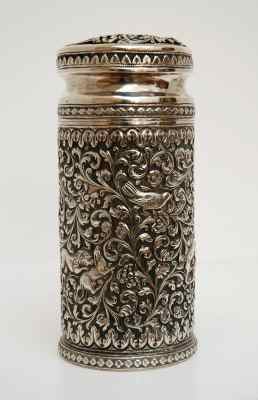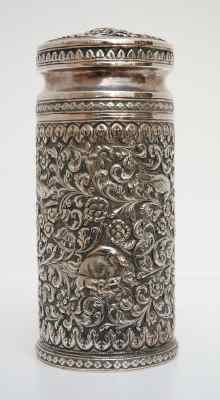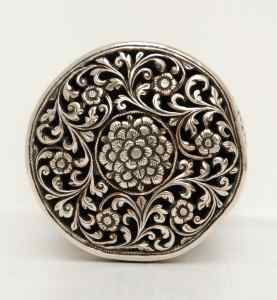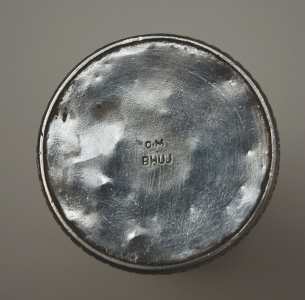by Michael
Thomas
(click on photos to enlarge image)
GLIMPSES OF INDIA'S HISTORY
Sugar sifter, Bhuj, Kutch, Gujarat, India


|
This piece has been in my family since it was
made and has triggered my interest in Indian silver over
the past twenty years. It stands about 6" (15 cm) high
and was made by Oomersi Mawji, a master silversmith who
worked in the remote town of Bhuj, Kutch in Gujarat.
Last November I spent two weeks in Bhuj and tried to
discover as much as possible about the silverwork from
this area.
Kutch used to be a small island with a strong maritime
history. Silver bullion was imported from Africa and
finished works were exported worldwide. The key point
was that this small state levied no tax on silver
imports and exports hence silverwork developed, thrived
and prospered.
bird and lion (left)
wild boar kill (right)
|
Oomersi is a common name in Kutch but OM and his
family is still well remembered. He was born about 1850
into a low caste Luhar (metalworkers) so was not highly
regarded by fellow Indians and could not marry outside
that caste. However he proved to be a very gifted
silversmith and this impressed Europeans who did not
attach such importance to caste and thus OM became
famous in India and overseas. OM used flora and fauna in
his designs a lot which fits with contemporary painting,
decorative textiles etc. The elegant Sarus cranes were a
speciality.
This sugar sifter was made around 1875 and is a good
everyday example of this detail craftsmanship. The
silver content is high at 97% and the O.M. mark is early
as in later pieces the initials were in a single panel.
His mark is classified under English (Colonial). There
is no doubt he was Indian and in my view his work should
be classified as such.
|

|

|
He produced work specifically for the Maharao of
Kutch and later he attracted the attention of the
Maharajah of Baroda who became his principal patron.
Consequently, this regular work of high quality led him
to move with his silversmith sons and family to Baroda.
His prime working years were probably between 1870 and
1890. The high quality and prices could not be sustained
so by 1900 the designs were simplified to cater for new
fashions and wider markets such as Liberty of London.
His sons had grown with the business and continued to
work in Baroda until the general demise of this type of
work around 1930.
The manufacturing technique is unusual and 'The Arts of
Kutch' ISBN: 8185026483 (recently corrected and
reprinted) gives a good detailed description. In summary,
the main form of the piece is made in thick sheet
silver, in this case a cylinder. This is filled with kil,
a hot mix of resin and wax, which after cooling gives a
solid core, allowing the outside to be hammered, punched,
and filed to produce high relief and great detail. To
obtain this level of detail the piece is heated and
cooled (annealed), refilled with kil up to three times.
The inside is left fairly smooth compared with repoussé
work and then lined with mercury and silver. The whole
is finally cleaned with weak nitric acid, burnished, and
highly polished.
|
5 Kori coin - Edward VIII
In 1617 Jahangir, the reigning Mughal Emperor, granted Rao Bharmal, head of the State of Kutch, the right to strike his own coinage,
the kori, and this rare privilege continued until 1948. The mint and treasury was in Bhuj, the capital city of Kutch.
Edward VIII was never crowned and although patterns were made no
coins were circulated as currency in Great Britain. The only
places in the world where they were used as currency were East
Africa, British West Africa and Kutch.
This 5 Kori coin is made from high quality silver and was
circulated. The rim is stamped ‘BHUJ KUTCH’ and the text reads
approximately as: "Edward 8th (the inverted ‘V’ is the
Persian numeral ‘8’), Kaiser-e-Hind (Emperor of India), Bhuj
1936".
The lettering around the edge of the coin is in Sanskrit and
reads "Maharaja dhiraj Mirjan Maharaj Shri Khengarji Savai
Bahadur". Maharao Kengar was a highly respected ruler who
died in 1942 and shortly before Independence.
|
|
 ASSOCIATION OF SMALL COLLECTORS OF ANTIQUE SILVER
ASSOCIATION OF SMALL COLLECTORS OF ANTIQUE SILVER ASSOCIATION OF SMALL COLLECTORS OF ANTIQUE SILVER
ASSOCIATION OF SMALL COLLECTORS OF ANTIQUE SILVER